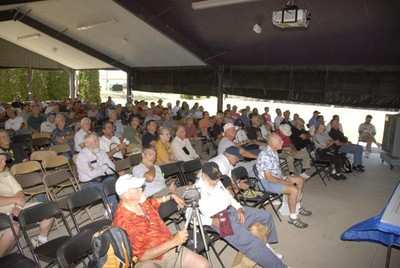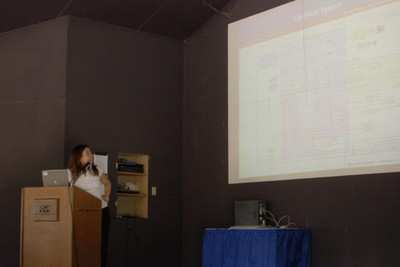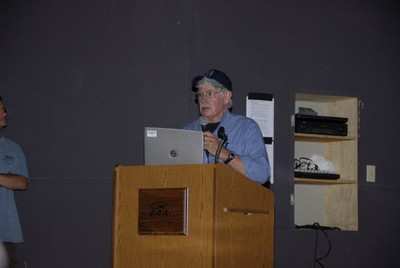Ethanol Debate Fuels Discussion
by ANN Correspondent Matt Russell
A panel of experts from various corners of General Aviation
gathered in a forum Monday to discuss how "alternative" fuels might
benefit the GA community. Three presentations were made, each
representing a different alternative fuel.

First was Dr. Nieves Lapena of Boeing Research & Technology
Europe, who reported on her Madrid, Spain-based team’s
ongoing effort to get a hydrogen fuel cell-powered airplane into
the sky. Boeing Research & Technology of Europe is funding the
project "...to prove that a fixed wing aircraft can achieve
straight and level flight with fuel cells as the only power
source," said Lapena.
The basis for Boeing’s project is a Diamond powered
glider, which originally was equipped with an 80bhp av-fuel engine.
Now in extremely modified form, the craft has been configured with
a powerful electric motor (output 45kw, according to Lapena), a
66-cell lithium-ion battery, and a large, pressurized hydrogen fuel
cell. Obviously, elaborate support systems are required and take up
a dramatic amount of space on board, says Lapena.
Test flights should take place in a few months. The large
battery pack (which may be charged by the fuel cell) provides power
for takeoff and climb. Once it reaches an altitude of nearly 500
meters, the craft will demonstrate a reduced power consumption in
cruise, supported solely by the fuel cell.

Elaborate safety systems have been engineered to adapt this
ground-bound technology for flight. The plane "...will require
extensive testing against [shutdowns and failures], because the
components weren’t originally designed for aviation use,"
says Lapena. Potential for "explosive atmospheres," or
ExAt’s, had to be addressed as well. Engineers separate areas
of the craft based on the ExAt risk factor, which is derived from
the varying proximities of hydrogen and electrical components on
board the craft. Lapena stressed that hi-performance "control
systems" will help protect the battery and fuel cell from the
possibility of overheating.
Next to the stage was ethanol and bio-diesel advocate Max
Schauck of Baylor University. Max’s mission is to promote
awareness of successful, practical applications of these fuels. He
flew a prototype Velocity across the Atlantic Ocean in 1989 burning
only 100% ethanol.
"Ethanol is for piston engines, and bio-diesel is for turbines,"
says Schauck. "We have dyno-proven that a Cessna 152 can make 20%
more power when burning 100% ethanol. But the downside is that we
lose between 12% and 25% of the range."
Although Schauck conceded ethanol does not have quite the
"energy density" of avgas, and thusly more consumption must occur
to obtain the same power output, one audience member was not
satisfied.
"You have to stop lying," shouted the man, who charged the
stage. "You have finally admit you’re selling a lie! It
doesn’t work… it just doesn’t work like you say
it does!"

When the angry man calmed down and rejoined the audience,
Schauck acknowledged the dissent and re-stated his position. "The
octane rating is lower, but at very high compression ratios you can
make a great deal of power," he said. "Because lead is a
neurotoxin, it is disappearing worldwide, and it will soon be gone,
so these solutions must be sought. We may need to build larger
tanks and fly shorter legs, but the cost-per-mile will still be
less."
Schauck concluded with some "gee-whiz" facts about Ethanol. "We
test for emissions and ethanol features a very low emission. With a
catalytic converter, which is development, ethanol emissions can be
near zero." He mentioned ethanol’s good cooling effect and
"incompatibility" with aluminum, which must be properly treated. In
Brazil, where ethanol sources are plentiful, farmers have amassed
some 500,000 hours of ethanol run-time in IO-540 powered crop
dusters, Schauck said.
The final presenter was Dennis Webb of DeltaHawk Engines, who
spoke briefly about the "heavy fuels" market for general aviation.
Heavy fuels include kerosene, JP5, JP8, and true diesel fuel, and
they showcase the virtues of high energy content, lack of explosive
behavior, and better lubricating properties.
"Diesel engines continue to improve," said Webb. "Several
advances have been made, but the most significant have centered on
how we control these engines," he said, referring to the latest
engine electronics.

Webb insisted upcoming aviation diesels will beat the efficiency
of today’s luxury cars, quoting a 34nm per gallon (efficiency
cruise) figure for a 200bhp aircraft engine that is more-compact
than an IO-360.
Audience members had plenty of questions for Webb about the
economy of diesels from a fixed cost standpoint. Questions centered
around time between replacement (rather than overhaul), and actual
purchase costs of the engines.
Frank Drefs, an audience member from EAA chapter 478 in Pax
River, MD, expressed a long-running interest in alternative fuels.
"I’m interested in the different fuels that may be
available," he said. "Maybe the best [fuels] won’t be
available through a distribution system owned by oil
companies."
 ANN's Daily Aero-Linx (04.16.24)
ANN's Daily Aero-Linx (04.16.24) Aero-News: Quote of the Day (04.16.24)
Aero-News: Quote of the Day (04.16.24) Airborne 04.10.24: SnF24!, A50 Heritage Reveal, HeliCycle!, Montaer MC-01
Airborne 04.10.24: SnF24!, A50 Heritage Reveal, HeliCycle!, Montaer MC-01 Airborne 04.12.24: SnF24!, G100UL Is Here, Holy Micro, Plane Tags
Airborne 04.12.24: SnF24!, G100UL Is Here, Holy Micro, Plane Tags Airborne-Flight Training 04.17.24: Feds Need Controllers, Spirit Delay, Redbird
Airborne-Flight Training 04.17.24: Feds Need Controllers, Spirit Delay, Redbird






